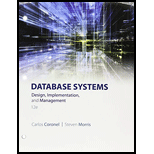
Concept explainers
“ORDER BY” Clause:
SQL contains “ORDER BY” clause in order to sort rows. The values get sorted in ascending as well as descending order. The keyword used to sort values in ascending order is “ASC” and for descending order is “DESC”. By default, it sorts values by ascending order.
Syntax:
SELECT column_Name1, column_Name2 FROM table_Name ORDER BY column_Name2;
“HAVING” clause:
“HAVING” clause is used limit groups.“HAVING” clause in used to overcome “WHERE” clause because, “HAVING” clause uses aggregate functions.
Syntax:
SELECT column_Name1, column_Name2 FROM table_name WHERE [conditions] GROUP BY column_name(s) HAVING [conditions] ORDER BY column_name;
“GROUP BY” Clause:
The GROUP BY clause is used to group the result of a SELECT statement done on a table where the tuple values are similar for more than one column.
Syntax:
SELECT expression1, expression2, expression_n, aggregate_function (expression)FROM table_name WHERE conditions GROUP BY expression1, expression2, expression_n;
Aggregate Functions:
SQL has some built-in functions and they are called as aggregate functions. SQL contains five built-in functions. They are:
- SUM – This function is used to add values from the particular column.
- Syntax: SELECT SUM(column_Name) FROM table_Name;
- COUNT – This is used to count the number of rows for the particular column.
- Syntax: SELECT COUNT(column_Name) FROM table_Name;
- MAX – This function is used to get the maximum value from the column.
- Syntax: SELECT MAX(column_Name) FROM table_Name;
- MIN – This function is used to get the minimum value from the column.
- Syntax: SELECT MIN(column_Name) FROM table_Name;
- AVG – This function is used to get the average of all the values from the column.
- Syntax: SELECT AVG(column_Name) FROM table_Name;
Trending nowThis is a popular solution!

Chapter 7 Solutions
Bundle: Database Systems: Design, Implementation, & Management, Loose-leaf Version, 12th + Lms Integrated For Mindtap Computing, 1 Term (6 Months) Printed Access Card
- Describe three (3) Multiplexing techniques common for fiber optic linksarrow_forwardCould you help me to know features of the following concepts: - commercial CA - memory integrity - WMI filterarrow_forwardBriefly describe the issues involved in using ATM technology in Local Area Networksarrow_forward
- For this question you will perform two levels of quicksort on an array containing these numbers: 59 41 61 73 43 57 50 13 96 88 42 77 27 95 32 89 In the first blank, enter the array contents after the top level partition. In the second blank, enter the array contents after one more partition of the left-hand subarray resulting from the first partition. In the third blank, enter the array contents after one more partition of the right-hand subarray resulting from the first partition. Print the numbers with a single space between them. Use the algorithm we covered in class, in which the first element of the subarray is the partition value. Question 1 options: Blank # 1 Blank # 2 Blank # 3arrow_forward1. Transform the E-R diagram into a set of relations. Country_of Agent ID Agent H Holds Is_Reponsible_for Consignment Number $ Value May Contain Consignment Transports Container Destination Ф R Goes Off Container Number Size Vessel Voyage Registry Vessel ID Voyage_ID Tonnagearrow_forwardI want to solve 13.2 using matlab please helparrow_forward
- a) Show a possible trace of the OSPF algorithm for computing the routing table in Router 2 forthis network.b) Show the messages used by RIP to compute routing tables.arrow_forwardusing r language to answer question 4 Question 4: Obtain a 95% standard normal bootstrap confidence interval, a 95% basic bootstrap confidence interval, and a percentile confidence interval for the ρb12 in Question 3.arrow_forwardusing r language to answer question 4. Question 4: Obtain a 95% standard normal bootstrap confidence interval, a 95% basic bootstrap confidence interval, and a percentile confidence interval for the ρb12 in Question 3.arrow_forward
 Database Systems: Design, Implementation, & Manag...Computer ScienceISBN:9781305627482Author:Carlos Coronel, Steven MorrisPublisher:Cengage Learning
Database Systems: Design, Implementation, & Manag...Computer ScienceISBN:9781305627482Author:Carlos Coronel, Steven MorrisPublisher:Cengage Learning
 Programming with Microsoft Visual Basic 2017Computer ScienceISBN:9781337102124Author:Diane ZakPublisher:Cengage Learning
Programming with Microsoft Visual Basic 2017Computer ScienceISBN:9781337102124Author:Diane ZakPublisher:Cengage Learning


